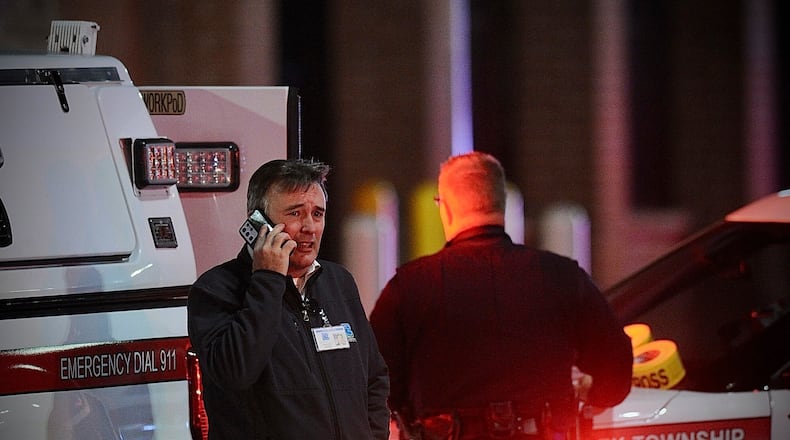Jones had Nazi materials in his house at the time of the attack, and the shootings “may have been at least partially inspired by Racially Motivated Violent Extremist (RMVE) ideology,” according to the Beavercreek PD and the FBI at the time.
Jones was also “pink-slipped” twice for homicidal or suicidal ideation the year before the shooting.
Efforts by local police to “pink slip” someone in a mental health crisis because an officer believes the person is a danger to themselves or others rarely result in the person being involuntarily committed, a Dayton Daily News investigation found.
One year after the shooting, little has changed.
“We’ve got a little bit of manpower and a whole lot of thoughts on paper,” said Montgomery County Probate Court Judge David Brannon about efforts to review the issue. “In practice is a different matter.”
Jones’ case was turned over to the FBI last November, according to Beavercreek police, and the investigation into his Nazi ties is still ongoing.
“Our hearts continue to go out to everyone affected by last year’s tragic incident in our community,” Beavercreek Police said in a statement this week. “The officers of the Beavercreek Police Department remain steadfast in their commitment to serve and protect with compassion and integrity.”
The Dayton area is in line for $10 million of state funding toward opening Ohio’s seventh state-run behavioral health hospital. Additionally, $6 million in opioid manufacturer settlement money will go toward turning 226 Montgomery County jail beds into 100 behavior health unit beds in the Montgomery County Jail.
While those solutions are still years away, other efforts are being made at the local level, particularly to increase communication between medical providers and the probate court, which oversees mental health adjudication. Montgomery County recently was awarded a $2 million grant for assisted outpatient treatment toward monitoring individuals in the community.
“We’d all like to see less civil commitments, but I don’t think that’s realistic, because I think, for whatever reason — social media, the pandemic, whatever — there’s more and more crises and higher-level episodes,” Brannon said. “So from our end, I would like to see us do better reporting and monitoring of cases.”
What is pink slipping?
A pink slip refers to what law enforcement and other agencies call an application for emergency admission, printed on pink paper, usually when individuals’ mental or behavioral health represents a risk to themselves or others.
“Pink slipping” can be initiated by various kinds of law enforcement, from police to probation officers, as well as by doctors, and the patient gets transported to a hospital emergency department.
Once at the emergency department, the person is evaluated by a physician, and then the hospital determines whether to release the person or keep them for a 72-hour hold.
If a person is held for 72 hours, they can be assigned a court-ordered mental health treatment plan from the probate court. Through the court process, state law may prohibit those individuals from owning a gun. Being committed for one’s mental health makes someone “a person with a mental illness subject to court order,” which means they would violate Ohio’s prohibition on “having weapons while under disability” if they had a gun, according to the Ohio Revised Code.
However, only 6% of pink slips make it before probate court.
“We end up shut off,” Brannon said. “We have no knowledge of what happens. We don’t see them at probate unless a pink slip is attached to an affidavit.”
Montgomery County is devising a process for compiling pink slips at the door of the hospital instead of after they’re admitted.
The county has also proposed a bill to Ohio’s state legislature that would allow the probate court to cause emergency administration of medication. Normally, for a court order to be in place, a person has to attend a hearing, and is entitled to due process before that happens.
However, that’s a lot of time that patients — and medical providers — don’t always have.
“You look at (the patient) and say, ‘Okay, are you under civil commitment, or were you here within the last six months? Or two years?’ ” Brannon said. “Those numbers are negotiable, but hey, you’ve gotten this order before. For court-ordered meds, we’re going to order it without (the patient) being present at a hearing like you would normally have. It basically suspends it under emergency ... without having to do a full-blown court hearing.”
However, the legislation has gotten little traction at the Statehouse.
Though reforms are slow, court-ordered treatment does work, Brannon said, recalling a mother who recently reached out to him about her daughter’s case the court handled almost a year ago.
“I remember she was 18 or 20,” he said. “Real young, and I remember the case was terrible ... and you know what, she’s now in her professional career and thriving. That was great. But a lot of times we don’t see the end result. I’d like to see us move more towards those results.”
Credit: JIM NOELKER
Credit: JIM NOELKER
About the Author





